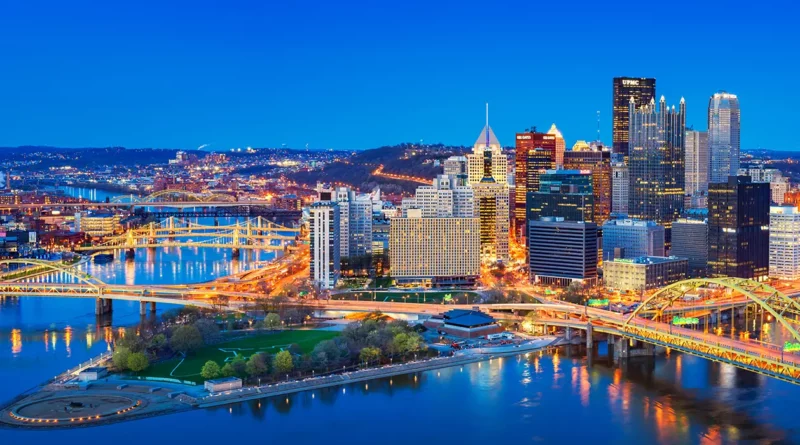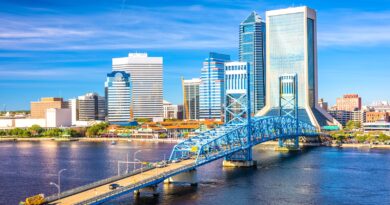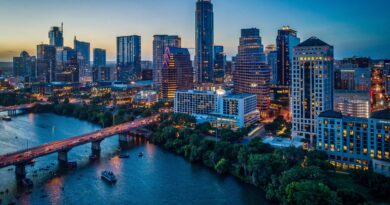History of Pittsburgh Pennsylvania
Nestled along the banks of the Allegheny, Monongahela, and Ohio Rivers, Pittsburgh, Pennsylvania, has a history as rich and diverse as the city itself. From its humble beginnings as a frontier outpost to its rise as a global industrial powerhouse, Pittsburgh’s story is one of resilience, innovation, and unwavering determination.
The origins of Pittsburgh can be traced back to the 18th century, when the region was a strategic point of contention between the French and British empires during the French and Indian War. In 1758, the British forces, led by General John Forbes, established a fortified settlement known as Fort Pitt, named in honor of the British Secretary of State, William Pitt. This fort would eventually become the genesis of the city we know today as Pittsburgh.
As the young nation grew, Pittsburgh’s location at the confluence of three mighty rivers made it an ideal transportation hub, facilitating the movement of goods and people. The city’s nascent industries, including glassmaking, boat building, and iron production, began to flourish, laying the foundation for Pittsburgh’s future as an industrial juggernaut.
The 19th century witnessed Pittsburgh’s rapid transformation into a manufacturing powerhouse. The city’s abundant natural resources, including coal and iron ore, coupled with its strategic location, attracted entrepreneurs and industrialists from across the nation. Names like Andrew Carnegie, Henry Clay Frick, and Andrew Mellon became synonymous with Pittsburgh’s booming steel industry, which fueled the city’s growth and earned it the moniker “Steel City.”
As Pittsburgh’s steel mills churned out vast quantities of metal, the city’s skyline evolved, with towering factories and smokestacks dotting the landscape. Immigrants from across Europe flocked to the city, seeking employment in the thriving industrial sector, contributing to Pittsburgh’s rich cultural tapestry and shaping its diverse neighborhoods.
The early 20th century marked a period of continued growth and innovation for Pittsburgh. The city’s universities, including the University of Pittsburgh and Carnegie Mellon University, emerged as centers of academic excellence, fostering groundbreaking research and technological advancements. Pittsburgh’s medical institutions, such as the University of Pittsburgh Medical Center (UPMC), also gained international recognition for their pioneering work in healthcare.
However, the latter half of the 20th century brought significant challenges to Pittsburgh’s steel industry. The rise of foreign competition and the adoption of new manufacturing methods led to a steep decline in the city’s once-dominant steel production. The collapse of the steel industry dealt a devastating blow to Pittsburgh’s economy, forcing the city to reinvent itself and diversify its economic base.
With resilience and determination, Pittsburgh embarked on an ambitious revitalization effort, transforming itself from a gritty industrial hub into a modern, livable city. The city’s leadership focused on attracting new industries, such as healthcare, finance, and technology, while investing in urban renewal projects and developing a vibrant cultural scene.
Today, Pittsburgh stands as a shining example of a city that has successfully navigated the challenges of deindustrialization and economic transition. Its skyline, once dominated by steel mills, now features modern skyscrapers housing cutting-edge companies and world-class research institutions. The city’s riverfront, once lined with factories, has been transformed into a recreational haven, with parks, trails, and cultural attractions drawing visitors from near and far.
Despite its metamorphosis, Pittsburgh’s rich industrial heritage remains deeply ingrained in its DNA. Historic neighborhoods like the Strip District and South Side continue to celebrate the city’s blue-collar roots, while museums like the Senator John Heinz History Center and the Carrie Blast Furnaces National Historic Landmark preserve and interpret Pittsburgh’s storied past.
From its humble beginnings as a frontier outpost to its rise as an industrial titan and its subsequent reinvention as a modern, diverse metropolis, Pittsburgh’s history is a testament to the enduring spirit of its people. This resilient city has weathered storms and emerged stronger, ever-evolving while remaining grounded in its rich cultural tapestry and unwavering determination.
Discover more from City Towner
Subscribe to get the latest posts sent to your email.




